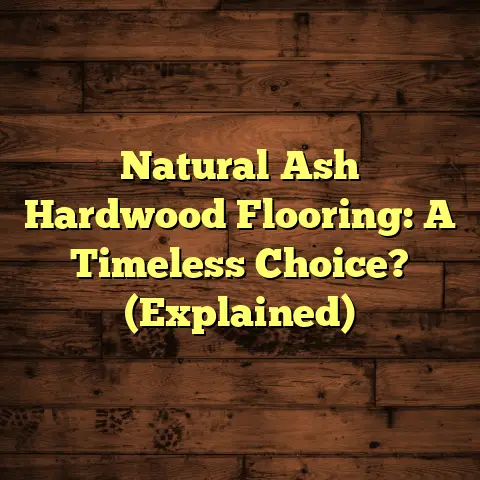Pergo Flooring: Real Wood or Not? (1 Big Lie!)
In a world where we strive for authenticity, it’s amusing to think that many homeowners believe their Pergo flooring is the real deal—when in fact, it’s more akin to a Hollywood set than a genuine wood masterpiece.
Introduction
Pergo flooring.
You’ve probably heard of it, maybe even have it in your home.
It’s a popular choice for both residential and commercial spaces, known for its durability and attractive appearance.
But here’s the million-dollar question: Is Pergo flooring real wood?
Or is there a big “lie” behind its appeal?
As a flooring contractor with years of experience, I’ve seen firsthand the confusion and misconceptions surrounding this product.
I’m here to set the record straight and give you the lowdown on what Pergo flooring really is.
In this article, we’ll dive deep into:
- The origins of Pergo and how it revolutionized the flooring industry.
- The materials that make up Pergo flooring (hint: it’s not just wood!).
- The marketing tactics that might have you thinking it’s the “real deal”.
- The advantages and disadvantages of choosing Pergo for your home.
- Real-life experiences from homeowners who live with Pergo every day.
- A head-to-head comparison with solid hardwood.
- Expert opinions from industry professionals.
So, buckle up, and let’s get to the bottom of this Pergo puzzle!
The Origins of Pergo Flooring
Let’s hop in our time machine and travel back to the 1970s.
Disco was king, and a Swedish company called Perstorp was looking for a way to use leftover wood materials from their other manufacturing processes.
Their solution?
Laminate flooring.
In 1977, they introduced Pergo to the market, and it quickly became a game-changer.
It offered a durable, affordable, and easy-to-install alternative to traditional hardwood.
But what exactly is laminate flooring?
Well, it’s a multi-layered synthetic flooring product fused together through a lamination process.
Unlike solid hardwood, which is made from a single piece of timber, laminate flooring is composed of several layers:
- Backing Layer: Provides stability and moisture resistance.
- Core Layer: Typically made of high-density fiberboard (HDF) or medium-density fiberboard (MDF).
This is the workhorse of the flooring, providing impact resistance and structural integrity. - Design Layer: A high-resolution photographic image that mimics the look of wood, stone, or tile.
- Wear Layer: A transparent, protective layer that shields the design layer from scratches, stains, and fading.
This layered construction is what sets Pergo and other laminate floors apart from traditional hardwood.
It’s engineered for durability and aesthetics, but it’s not real wood in the purest sense.
Understanding the Composition of Pergo Flooring
Now, let’s break down each layer of Pergo flooring to understand what it’s really made of.
- The Core Layer: This is where the strength comes from.
As I mentioned earlier, it’s usually made of HDF or MDF.
HDF is denser and more water-resistant than MDF, making it a better choice for areas prone to moisture.
Think of it like the foundation of a house – it needs to be solid! - The Design Layer: This is the visual appeal.
It’s a high-resolution photograph printed on paper.
The quality of this image is crucial because it determines how realistic the flooring looks.
Some Pergo floors have incredibly realistic textures and patterns that can fool the eye. - The Wear Layer: This is the shield that protects the design layer.
It’s a clear, durable coating that resists scratches, stains, and fading.
The thickness of the wear layer is measured in mils (thousandths of an inch).
A thicker wear layer means more protection and a longer lifespan for your floor.
Now, let’s compare these materials to solid hardwood.
Solid hardwood is, well, solid wood!
It’s made from a single piece of timber, like oak, maple, or walnut.
There are no layers, no photographs, just pure, natural wood.
As you can see, the composition of Pergo flooring is vastly different from solid hardwood.
While Pergo can mimic the look of wood, it’s not the same thing.
The Big Lie: Pergo Flooring is Real Wood
Okay, let’s address the elephant in the room: the “big lie.” Is Pergo flooring real wood?
The simple answer is no.
But why do so many people think it is?
Part of the reason lies in the marketing strategies employed by Pergo and other laminate flooring manufacturers.
They often use terms like “wood look” or “realistic wood finish” to describe their products.
While technically true, these phrases can be misleading.
They create the impression that you’re getting something close to real wood when you’re not.
I’ve also seen showrooms where Pergo is displayed alongside real hardwood, making it difficult for the average consumer to tell the difference at first glance.
The visual appeal of the design layer, combined with clever marketing, can easily lead people to believe they’re buying real wood.
To further emphasize the point, let me share some anecdotes from homeowners I’ve worked with over the years:
- Sarah from Chicago: “I thought I was getting a great deal on hardwood flooring.
The salesperson kept talking about how ‘real’ it looked.
It wasn’t until after it was installed that I realized it wasn’t actual wood.” - Mark from Denver: “I specifically asked if it was real wood, and they said it was ‘wood-based.’ I took that to mean it was real wood.
I feel like I was tricked.” - Lisa from Miami: “I loved the color and the texture, and the price was right.
I didn’t even think to ask if it was real wood.
I just assumed it was.”
These are just a few examples of how consumers can be misled by marketing claims and assumptions.
It’s crucial to do your research and ask the right questions before making a purchase.
The Advantages of Pergo Flooring
Now, before you write off Pergo completely, let’s talk about its advantages.
Despite not being real wood, it offers several benefits that make it a popular choice for many homeowners.
- Affordability: Pergo is significantly cheaper than solid hardwood.
This makes it an attractive option for those on a budget. - Durability: Pergo is designed to withstand heavy foot traffic, scratches, and stains.
The wear layer provides excellent protection against everyday wear and tear. - Ease of Installation: Pergo is relatively easy to install, especially with the click-lock systems available today.
Many homeowners can even tackle the installation themselves, saving on labor costs. - Variety of Styles and Finishes: Pergo comes in a wide range of styles, colors, and textures.
You can find options that mimic the look of various wood species, stone, and tile. - Easy Maintenance: Pergo is easy to clean and maintain.
A simple sweep or mop is usually all it takes to keep it looking its best.
These advantages make Pergo a practical choice for busy households, rental properties, and areas where durability is a top priority.
The Disadvantages of Pergo Flooring
Of course, Pergo isn’t without its drawbacks.
Let’s take a look at some of the disadvantages you should consider before making a decision.
- Lack of Long-Term Value: Unlike solid hardwood, Pergo doesn’t appreciate in value over time.
It’s a synthetic product that will eventually need to be replaced. - Potential for Scratching: While Pergo is durable, it’s not indestructible.
Sharp objects, heavy furniture, and pet claws can still scratch the wear layer. - Limitations in Refinishing: You can’t refinish Pergo flooring.
Once the wear layer is damaged, the only option is to replace the affected planks or the entire floor. - Environmental Impact: The production of laminate flooring involves the use of synthetic materials and chemicals.
While some manufacturers are making efforts to improve sustainability, the environmental impact is still a concern.
Another thing I’ve noticed is that Pergo flooring can sometimes feel “hollow” underfoot compared to solid hardwood.
This is due to the core layer and the way it’s installed.
It can also be more prone to noise, as footsteps and impacts can create a louder sound.
Consumer Insights: The Realities of Living with Pergo
Let’s get real for a moment and talk about what it’s like to live with Pergo flooring.
I’ve gathered some insights from homeowners who have had Pergo in their homes for years.
- Water Damage: One of the biggest concerns is water damage.
While some Pergo products are water-resistant, they’re not waterproof.
Spills need to be cleaned up quickly to prevent water from seeping into the core layer, causing swelling and damage. - Fading: Over time, the design layer can fade, especially in areas exposed to direct sunlight.
This can make the floor look worn and uneven. - Wear Over Time: Even with proper care, Pergo flooring will eventually show signs of wear.
The wear layer can become scratched and dull, and the edges of the planks can start to chip or peel.
However, many homeowners are happy with their Pergo flooring.
They appreciate the durability, affordability, and ease of maintenance.
It really comes down to managing expectations and understanding the limitations of the product.
Comparative Analysis: Pergo vs. Solid Hardwood Flooring
Now, let’s get down to brass tacks and compare Pergo and solid hardwood side-by-side.
As you can see, each type of flooring has its pros and cons.
Pergo is a budget-friendly and durable option, while solid hardwood offers timeless beauty and long-term value.
Expert Opinions on Pergo Flooring
To get a broader perspective, I spoke with other flooring experts, contractors, and interior designers about their thoughts on Pergo flooring.
- John, a flooring contractor: “Pergo is a great option for homeowners who want the look of wood without the high cost.
It’s easy to install and holds up well in high-traffic areas.” - Maria, an interior designer: “I often recommend Pergo to clients who have pets or young children.
It’s durable and easy to clean, which is a must for busy families.” - David, a real estate agent: “While Pergo can be a good choice for certain situations, it doesn’t add as much value to a home as solid hardwood.
If you’re planning to sell your home in the future, hardwood is a better investment.”
One trend I’ve noticed is the growing popularity of engineered wood products.
Engineered wood flooring consists of a thin layer of real wood veneer bonded to a core of plywood or HDF.
It offers a compromise between the affordability of laminate and the beauty of solid hardwood.
Conclusion
So, there you have it.
We’ve explored the origins, composition, advantages, and disadvantages of Pergo flooring.
We’ve debunked the myth that it’s real wood and examined the realities of living with it.
While Pergo flooring offers certain advantages, like affordability and durability, it’s fundamentally not real wood.
It’s a synthetic product designed to mimic the look of wood.
And while it can do a pretty good job, it’s important to understand what you’re really getting.
I encourage you to reconsider your flooring choices based on informed decisions rather than marketing hype.
Don’t be afraid to ask questions, do your research, and compare different options.
Your floors are a big investment, so make sure you choose something that you’ll love for years to come.
Remember, there’s no shame in choosing Pergo if it fits your budget and lifestyle.
Just be aware of what it is and what it isn’t.
And don’t let anyone tell you it’s the “real deal” when it’s not.





